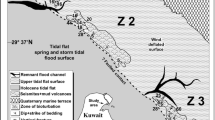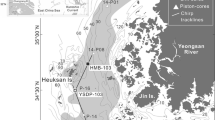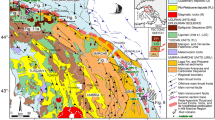Abstract
Drilling two mud domes on the Mediterranean Ridge during ODP Leg 160 has demonstrated that the eruption of mud breccia began at least 1.5 Ma ago. An evolution through extrusive building of a cone, followed by successive eruptions of clast-bearing mud debris flows and subsequent subsidence can be deduced for both domes. Results from permeability and shear strength tests, grain size analyses, sedimentary textures, and clast provenance provide clues concerning the mechanism of mud volcanism. The collision of Africa with Eurasia resulted in backthrusting of the evaporite-dominated accretionary wedge against a rigid backstop. This allowed egress of overpressured fluid-rich mud of presumed Messinian age from the décollement, although many of the clasts may have originated from the overlying accretionary wedge.
Similar content being viewed by others
Author information
Authors and Affiliations
Rights and permissions
About this article
Cite this article
Kopf, A., Robertson, A., Clennell, M. et al. Mechanisms of mud extrusion on the Mediterranean Ridge Accretionary Complex. Geo-Marine Letters 18, 97–114 (1998). https://doi.org/10.1007/s003670050058
Issue Date:
DOI: https://doi.org/10.1007/s003670050058




